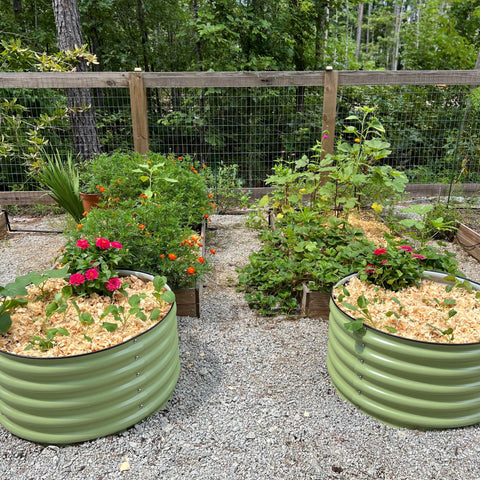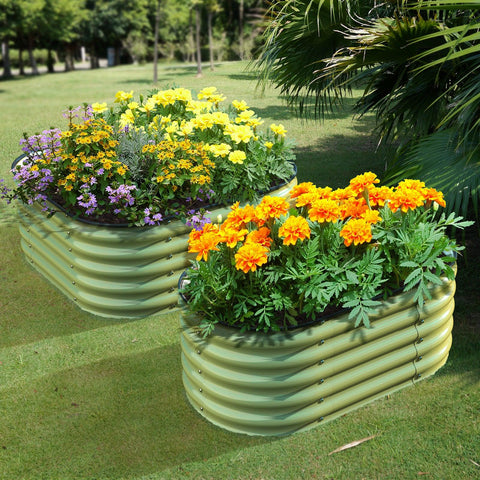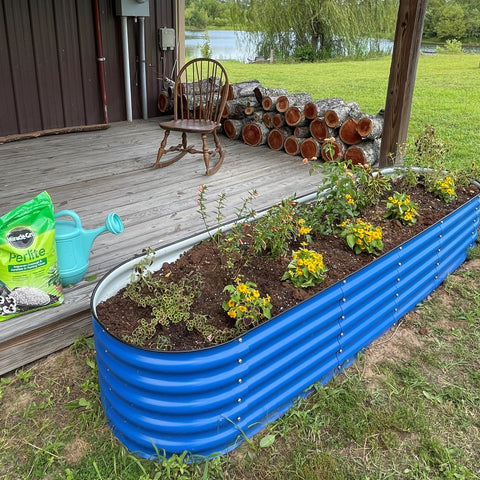Garlic In a Raised Garden Bed
Garlic is one of the most valuable things you can grow yourself. Garlic bulbs are delicious and can last for aAs the growing season is coming, we are considering the schedule. You may want to know: How long does it take for garlic to grow? Here's what Olle is going to talk about.
Although most varieties need about 9 months to mature when they propagate from cloves, some short season varieties need less time. The way you grow garlic also depends on when it is ready to harvest. Some garlic types allow you to easily reproduce and replant garlic from last year's harvest, while others are more suitable for immediate use.
Growing garlic involves deciding whether you want to use garlic grown in the spring or autumn. Your USDA planting area is an important consideration. Problems in growing garlic can also change your time.

Therefore, let's examine all these factors to help you determine the type of garlic bulb and the planting time, so that you can enjoy your own garlic in the next few years.
Growth from seed v Growth from clove
In addition to harvesting garlic landscape, you can also plant garlic in different garlic growth stages. After harvesting garlic, growers solidify each garlic bulb in good air circulation, and store garlic in various ways. During the growing process, gardeners can collect garlic seeds from flowers so that they can grow again the next year. They can also choose to plant garlic cloves, each serving as its own seed.
Which type you choose to plant will affect your harvest time. Although cloves are planted for about 9 months, garlic seeds take more than a year than garlic bulbs (sometimes called bulbs). This is because the seed must germinate, grow green plants needed for photosynthesis, and then go through the process of bulb formation. When you plant cloves, the first half of the process is complete.
If you plan to plant garlic plants in the coming growing season, please consider the variety and its source! This will help you decide when to plant garlic. There are some garlic varieties in cold climate. When the temperature is low, they like it best.
When to plant garlic
Another consideration in knowing when to harvest garlic is planting time. Although there are garlic planted in spring and autumn on the whole, there are also climates to consider. Soft necked garlic is better planted in warm climates, while hard necked garlic is best planted in colder climates. The difference between them also exists in their botany. We will discuss these in a later section.

Time by region
Garlic is usually part of autumn planting, 4 to 6 weeks before the first frost in early summer to early autumn. It is also the most common garlic planted in autumn, because it can produce larger bulbs in cold winter. This general list is applicable to autumn planting. It is possible to plant garlic in spring. It usually occurs 4 to 6 weeks before the last frost in early spring. The soft neck varieties are suitable for the mild climate in Zone 6 and higher regions, but there are also varieties that can adapt to cold weather, such as the Polish soft neck.
The time you plant cloves may depend only on the season you plan, which largely depends on your USDA growing area. The following is a rough breakdown of when to plant garlic according to type and USDA planting area.
Area 0-3: late August to early September to late September
Zone 3-5: mid September to mid October to mid October
Zone 5-7: early October to late October
Area 7-9: late October to November
Area 9-10: late October to December
If you are planting garlic companion plants and onions, use their planting time to determine when to start planting garlic plants. For example, grow tomatoes next to garlic to prevent spider mites.

Garlic growth type
Whether you are interested in making garlic sprays, or want to make garlic sauce or produce garlic, just like the kind of garlic you buy in the store, the type of garlic you grow is related to how you grow them. Soft neck and hard neck determine whether you are planting in autumn or spring. Garlic planting in autumn should be cold resistant and ready in midsummer. Spring planting should be ready in autumn (depending on whether you are planting cloves or bulbs, whether current or subsequent). In a place where the growing season is long and cold enough, you may find that garlic can be harvested many times a year.
So let's talk about the types of garlic you can grow and how it can change your harvest time.
Garlic with hard neck
Hard neck garlic is called hard garlic because it has a stem in the center of the big garlic, which will become hard when it is mature. It has long flower stems, which produce bulbs after flowering. It is usually cold resistant and easier to peel because it has thick skin. Each garlic bulb has only a few petals. In this case, the harder the neck, the bigger the clove. If you plant and store garlic of the hard necked variety, you will find that it is not as long as the garlic bought in the store. As we mentioned earlier, this garlic grows best in cold climates. Some of the best hard necked varieties are rocambole, purple stripes and porcelain.
When it comes to the timing of hard neck harvesting, when the bottom 1/3 leaves turn yellow, you will know that they are ready. As this variety is usually planted in autumn, you will harvest it from early summer to midsummer. Before that, you must remove the green leaves called garlic landscape to ensure a decent harvest. This can promote the growth of lilac, starting from the bulb and starting from the root growth.
Soft neck garlic
Soft neck garlic has a soft stem made of green garlic leaves, rather than a hard stem. Soft necks do not bloom - usually not anyway - and therefore do not produce bulbs. Mature bulbs have more cloves than stiff necks, and they are much smaller. The garlic skin on the soft neck is paper, which is difficult to peel. This garlic grows best in warm climates and is usually grown in spring. Soft necked cloves must be planted to reproduce. This is the type you get when you buy garlic at the grocery store. Two great varieties of soft neck are silver peel and artichoke garlic.

To identify garlic types that fall into the soft neck category, know that they can be prepared as early as the beginning of spring. Wait until the top 5 to 6 leaves are still green, and the bottom leaves turn brown. Then remove them with a garden fork.
elephant garlic
Technically, elephant garlic is not real garlic, but it is always included in other types of garlic we have discussed so far. Elephant garlic varieties form bulbs, where there are the largest cloves. When it comes to elephant varieties, each big garlic contains no more than 6 cloves, while most garlic has 10 to 12 cloves. Each elephant garlic clove can be eaten after a little cooking. This is why it is a delicious garlic for spreading sauce. If you need garlic ready quickly, go to the elephant. You will split the garden for harvesting within 90 days of planting.
Garlic vegetable
If you are interested in growing garlic purely for green vegetables, you should know that you can harvest garlic many times in a growing season. However, you must wait until late spring and early summer to do so. This is because the bulb needs green to continue to form until harvest. If you do not want to harvest the bulbs at the same time, remember to place the leaves on the plant.
soil moisture
Because garlic needs a lot of water to grow, you need to keep the garden soil moist throughout the growth process. In most cases, poor harvest is caused by dry soil. Especially if you grow in a sunny place, it is important to continuously monitor the moisture content in the soil. But you don't want to use too much water. This may cause the bulb to rot. This is where the growth medium can be used. A modified mixture of garden compost, rotting compost and sand will promote moisture, but also help drainage. Add 2 tablespoons of 5-10-10 fish meal to provide the required nutrition for the bulb. Covering with pine needles helps the soil retain moisture even in direct sunlight. Keep this in mind when preparing your website.

pest
Onion maggots do not do much damage to the harvest at first, but after several generations, they will cause up to 50% of the yield loss. They first feed on garlic seedlings, and then on swollen bulbs in the second and third generations. Insecticides applied to the planting area before planting will help eliminate the threat of onion maggots. The spines applied to the seeds also stop them. Maggots and onion maggots are the same pests, but the adult form. The preventive methods to control them are cultural. Take turns planting garlic crops to prevent them. This also prevents the erosion of the soil during the planting of delicious garlic bulbs.
The dry bulb mites also feed on garlic and reduce the yield, delaying the harvest. They belong to the same category as ticks and mites. They overwinter in the stored cloves, and the affected plants are poorly developed. The female lays eggs on the garlic leaves and hatches hundreds of larvae, which flow to the bulb to eat. Crop rotation will allow your garlic to grow at a normal rate and prevent these mites. The hot water treatment of garlic seeds also keeps them away. Neem sprayed on non flowering plants can prevent mites from laying eggs entirely on your leaves.
Please consider these when gardening to ensure that you have timely and abundant garlic harvest.
common problem
Q: How do you know when garlic is ready for harvest?
A: It depends on the type of person you are growing up. See above!
Q: When is the best month to plant garlic?
Answer: Most garlic is best planted from late summer to early autumn. However, you can also plant some varieties in spring.
Q: How long does it take for garlic to germinate?
A: Cloves germinate within 4 to 8 weeks. Bulbs take 8 to 9 months.
